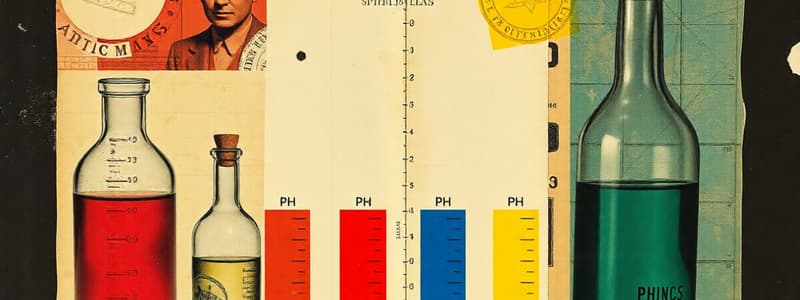Podcast
Questions and Answers
What is the function of indicators like red litmus and phenolphthalein in the context of acids and bases?
What is the function of indicators like red litmus and phenolphthalein in the context of acids and bases?
- To neutralize the acid or base before testing
- To identify the specific type of acid or base present
- To determine the concentration of the acid or base
- To indicate whether a substance is acidic or basic by color change (correct)
Which of the following acids was not mentioned as collected from the laboratory?
Which of the following acids was not mentioned as collected from the laboratory?
- Hydrochloric acid (HCl)
- Sulphuric acid (H2SO4)
- Carbonic acid (H2CO3) (correct)
- Nitric acid (HNO3)
What is the primary purpose of using olfactory indicators in acid-base testing?
What is the primary purpose of using olfactory indicators in acid-base testing?
- To neutralize the chemical being tested
- To provide a visual change in color when tested
- To enhance the reactivity of the acids and bases
- To produce a smell that indicates acidity or basicity (correct)
During the testing of the cloth strips soaked with chopped onions, what should be used on one strip?
During the testing of the cloth strips soaked with chopped onions, what should be used on one strip?
Which pair of substances can be categorized as bases in the collected solutions?
Which pair of substances can be categorized as bases in the collected solutions?
Which of the following observations would indicate a chemical reaction occurred when zinc granules are added to dilute sulfuric acid?
Which of the following observations would indicate a chemical reaction occurred when zinc granules are added to dilute sulfuric acid?
What is the correct reaction formula for the interaction between metals and acids based on the provided content?
What is the correct reaction formula for the interaction between metals and acids based on the provided content?
When testing the odour of dilute vanilla essence and clove oil with acids and bases, which of the following statements is true?
When testing the odour of dilute vanilla essence and clove oil with acids and bases, which of the following statements is true?
What forms as a result of the reaction between acid and metal?
What forms as a result of the reaction between acid and metal?
In the experiment where zinc is added to sodium hydroxide solution, what should be the expected outcome if the mixture is warmed?
In the experiment where zinc is added to sodium hydroxide solution, what should be the expected outcome if the mixture is warmed?
Flashcards are hidden until you start studying
Study Notes
Acids and Bases in the Laboratory
- Acids and bases can be identified using indicators which change colour under acid or base conditions
- Some indicators show colour changes while others demonstrate changes in odour
- Acids react with many metals to form salts and hydrogen gas
Chemical Properties of Acids and Bases
- Acids react with bases in a neutralisation reaction
- Acid + Base → Salt + Water
How Strong are Acid or Base Solutions?
- The pH scale is a measure of the strength of an acid or base solution.
- The pH scale ranges from 0 (very acidic) to 14 (very basic)
- A neutral solution has a pH of 7
- A solution with a pH less than 7 is acidic
- A solution with a pH greater than 7 is basic
Water of Crystallisation
- Some salts contain water molecules as part of their crystalline structure
- These water molecules are called water of crystallisation
- Water can be removed by heating, resulting in a change in colour
- The water can be reintroduced by adding water again to the salt
- Upon adding water the original colour of the salt is restored
Plaster of Paris
- Plaster of Paris is calcium sulphate hemihydrate (CaSO4.1/2H2O)
- It is formed by heating gypsum (CaSO4.2H2O) at 373 K
- Plaster of Paris is used in medicine to support fractured bones
Studying That Suits You
Use AI to generate personalized quizzes and flashcards to suit your learning preferences.




